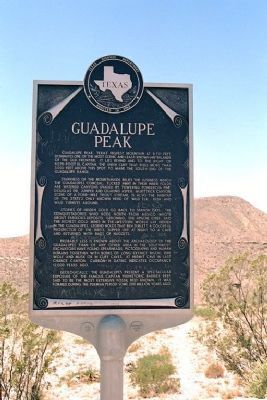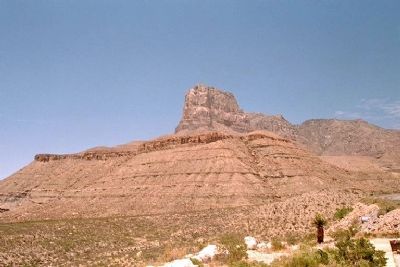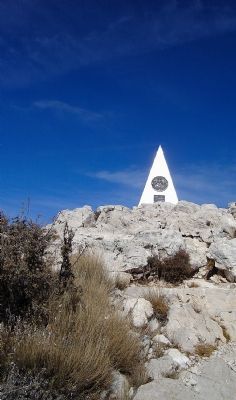Near Pine Springs in Culberson County, Texas — The American South (West South Central)
Guadalupe Peak
Starkness of the mountainside belies the lushness which the Guadalupes conceal. Tucked away in their inner folds are watered canyons shaded by towering ponderosa pine, Douglas fir, juniper and quaking aspen. McKittrick Canyon, scene of a four-mile trout stream, is also the habitat of the state's only herd of wild elk. Deer and turkeys abound.
Stories of hidden gold go back to Spanish days. The conquistadors who rode north from Mexico wrote about fabulous deposits. Geronimo, the Apache chief, said the richest gold mines in the western world lay hidden in the Guadalupes. Legend holds that Ben Sublett, a colorful prospector of the 1880s, slipped off at night to a cave and returned with bags of nuggets.
Probably less is known about the archaeology of the Guadalupes than of any other area in the Southwest. Excavators have found spearheads, pictographs and human remains together with bones of long-extinct bison, dire wolf and musk ox in cliff caves. At Hermit Cave in Last Chance Canyon, carbon-14 dating indicates occupancy 12,000 years ago. Geologically, the Guadalupes present a spectacular exposure of the famous Capitan prehistoric barrier reef, said to be the most extensive fossil organic reef known. It was formed during the Permian Period some 200 million years ago.
Erected 1963 by Texas Highway Department. (Marker Number 4759.)
Topics. This historical marker is listed in these topic lists: Landmarks • Natural Features.
Location. This marker has been replaced by another marker nearby. 31° 51.256′ N, 104° 50.69′ W. Marker is near Pine Springs, Texas, in Culberson County. Marker is on U.S. 62/180, 3 miles north of Texas Highway 54. Marker is in a rest area. Touch for map. Marker is in this post office area: Salt Flat TX 79847, United States of America. Touch for directions.
Other nearby markers. At least 8 other markers are within 5 miles of this location, measured as the crow flies. A different marker also named Guadalupe Peak (within shouting distance of this marker); The "Committee of Five" (approx. 3.1 miles away); Stephen Tyng Mather (approx. 3.1 miles away); Groundbreaking for the Pine Springs Visitor Center (approx. 3.1 miles away); The Airmen (approx. 3.1 miles away); Ruins of "The Pinery" or "Pine Spring" Stage Stand (approx. 3.2 miles away); Butterfield Overland Mail (approx. 3.2 miles away); Frijole Historic Site (approx. 4˝ miles away). Touch for a list and map of all markers in Pine Springs.
Regarding Guadalupe Peak. This marker was replaced by a new one also named Guadalupe Peak (see nearby markers).
Credits. This page was last revised on June 16, 2016. It was originally submitted on January 15, 2008, by Mike Stroud of Bluffton, South Carolina. This page has been viewed 2,576 times since then and 59 times this year. Photos: 1, 2. submitted on January 15, 2008, by Mike Stroud of Bluffton, South Carolina. 3. submitted on January 15, 2008, by Kevin W. of Stafford, Virginia. • Kevin W. was the editor who published this page.


